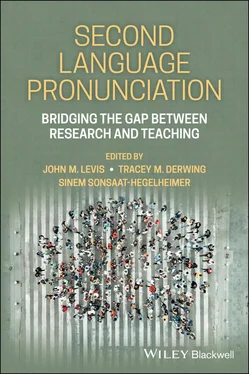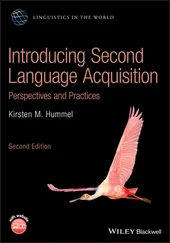Second Language Pronunciation
Здесь есть возможность читать онлайн «Second Language Pronunciation» — ознакомительный отрывок электронной книги совершенно бесплатно, а после прочтения отрывка купить полную версию. В некоторых случаях можно слушать аудио, скачать через торрент в формате fb2 и присутствует краткое содержание. Жанр: unrecognised, на английском языке. Описание произведения, (предисловие) а так же отзывы посетителей доступны на портале библиотеки ЛибКат.
- Название:Second Language Pronunciation
- Автор:
- Жанр:
- Год:неизвестен
- ISBN:нет данных
- Рейтинг книги:5 / 5. Голосов: 1
-
Избранное:Добавить в избранное
- Отзывы:
-
Ваша оценка:
- 100
- 1
- 2
- 3
- 4
- 5
Second Language Pronunciation: краткое содержание, описание и аннотация
Предлагаем к чтению аннотацию, описание, краткое содержание или предисловие (зависит от того, что написал сам автор книги «Second Language Pronunciation»). Если вы не нашли необходимую информацию о книге — напишите в комментариях, мы постараемся отыскать её.
Second Language Pronunciation: Bridging the Gap Between Research and Teaching
Second Language Pronunciation: Bridging the Gap Between Research and Teaching
Second Language Pronunciation — читать онлайн ознакомительный отрывок
Ниже представлен текст книги, разбитый по страницам. Система сохранения места последней прочитанной страницы, позволяет с удобством читать онлайн бесплатно книгу «Second Language Pronunciation», без необходимости каждый раз заново искать на чём Вы остановились. Поставьте закладку, и сможете в любой момент перейти на страницу, на которой закончили чтение.
Интервал:
Закладка:
For displaced people, education has long been a limited commodity. In 2019, the United Nations High Commission on Refugees reported that only 63% of refugee children attend primary school, while only 24% attend secondary school. Resettled refugees, asylum seekers, and family reunification immigrants who have experienced no or interrupted schooling face a steep learning curve when they arrive in language classes. Over the years, the literacy researchers who have focused on this understudied population have documented evidence of what ABE teachers have always known instinctively; adults who are not literate in a native language learn a new language differently from literate adults and from children learning to read for the first time (Bigelow & Tarone, 2004; Gardner et al., 1996; Malicky & Derwing, 1993). Traditional methods of teaching pronunciation, which are tied to textbooks and require a basic level of literacy, do not work for these learners. Literacy-level learners need much more than alphabetics and phonics instruction to become successful readers. They also need extensive instruction in speaking and listening to build the necessary foundation for literacy skills. To this end, explicit pronunciation instruction is a crucial component in the development of reading skills (Walter, 2008). Strube (2009, p. 49) writes that literacy-level learners often have a very restricted grasp of second language (L2) oral skills, which results in an “inadequately developed” lexicon and working knowledge of sounds, words, and sentences in the target language. Research with literacy-level learners has shown that oral processing is interconnected with print literacy, making it more challenging to complete target language verbal tasks that require phonemic and phonological awareness; likewise, a lack of alphabetic print literacy makes it harder for learners to focus on the segments of the target language (Bigelow & Vinogradov, 2011; Kurvers et al., 2006; Tarone, 2010; Tarone et al., 2009). Researchers have found that young children (Ehri & Wilce, 1985; Liberman, Shankweiler, Fisher, & Carter, 1974) and adults (Kurvers et al., 2006) who were identified as non-readers were able to segment utterances by syllables but not able to segment utterances by phonemes or words, leading to “fuzzy and imprecise word representations” (Darcy, 2018, p. 25) and difficulty recognizing and producing target words. Developing a working oral vocabulary paves the way for literacy skills: without it, reading is akin to “sounding out nonsense words” (Kurvers, 2007, p. 41).
Research on Pronunciation Integration
Those interested in teaching second language pronunciation have long asserted that pronunciation is usually neglected in favor of other aspects of language. This does not mean that pronunciation is not taught. Instead, it means that language teachers fall into two general categories when it comes to teaching pronunciation. Teachers in the first category view pronunciation as an essential focus of instruction, and they ensure that pronunciation is connected and extended to the teaching of other skills. Teachers in the second category have a drastically different approach to pronunciation because of a different instructional focus, such as reading comprehension, employment skills, grammar and composition, or general language learning with all four modalities (reading, writing, speaking, and listening). Teachers in this category tend to shoehorn pronunciation activities into their lessons if they teach it at all, resulting in a non-systematic and unstructured approach, only addressing pronunciation when errors are too severe to ignore. It is teachers in the second category that we address here, showing how incorporating pronunciation into everyday lessons can strengthen their class outcomes.
Pronunciation researchers and teachers regularly recommend integrating pronunciation into the language teaching classroom, both to ensure that it is actually taught and because of the assumption that pronunciation will be learned more effectively when it is integrated with other skills (Jones, 2016; Levis & Grant, 2003; Murphy, 1991; Sicola & Darcy, 2015). Unfortunately, we know very little about how pronunciation is actually integrated into instruction, although recent research suggests that integrating pronunciation is effective in improving learners’ comprehensibility (Darcy et al., 2021). We do know that pronunciation may not be effectively integrated into classroom instruction because of invisible obstacles that make changing usual ways of teaching difficult. First, published materials often do not include or integrate pronunciation. If they include pronunciation, the activities are presented as an extra that can be skipped under time pressure (Levis & Sonsaat, 2016). Second, many teachers are uncertain how to include pronunciation and lack confidence in their ability to teach pronunciation (Baker, 2014; Burri, 2015; Macdonald, 2002), resulting in a corresponding lack of planning. Third, curricular time pressures may make it hard for teachers to integrate pronunciation (Darcy, 2018; Darcy et al., 2021; Derwing, 2008). Finally, because pronunciation is not assessed, it is often seen as an extra than can safely be ignored, especially in contexts in which standardized, high-stakes tests are important. Indeed, a lack of even low-stakes testing for pronunciation means that teachers and learners are left not knowing what is important and what is not.
We propose that pronunciation should be carefully and consciously integrated into language instruction from the beginning because it will ensure that pronunciation is actually taught; it is more pedagogically sensible to integrate pronunciation than to teach it as a separate skill; and it is more likely that integrating pronunciation will improve L2 learners’ other language skills than teaching these skills without pronunciation. In principle, there are a multitude of ways to integrate pronunciation into language teaching because whenever we speak, we pronounce, and whenever we listen, we interpret others’ pronunciations. More specifically, formulaic language, which helps learners move into more communicative language use (such as repeated questions, e.g., How ARE you? Fine, how are YOU? ), depends upon pronunciation differences for successful communication. Vocabulary learning requires sensitivity to and knowledge of the system of word-level prosody, which in turn influences speech intelligibility. Progression in literacy skills depends on connecting oral and written representations of words and sentences. Perceptions of spoken fluency are bound to how speakers segment speech into easily understandable phrases, marked by pauses and intonation. And understanding others in natural conversational speech requires knowledge of how pronunciation of connected speech differs from pronunciation of words in isolation (Cauldwell, 2013).
Because pronunciation is connected and often essential to the learning of other language skills, teaching pronunciation as a stand-alone topic may be valuable (French et al., 2020; Lee et al., 2015), but it is an incomplete example of the kind of integration we are advocating, even though dedicating certain lessons fully to pronunciation may be a helpful strategy as part of an overall approach to integration (Darcy et al., 2021). Table 2.1shows two general approaches to integration. The first makes pronunciation preeminent and integrates it by including work on other language skills. In the second approach, pronunciation is integrated by emphasizing other language skills and identifying where pronunciation is essential to teaching them. We address the second approach in this chapter.
Table 2.1 Two general approaches to integrating pronunciation with other skills.
| (1) Pronunciation-focused Integration | (2) Other Skills-focused Integration |
|---|---|
| GOAL: To teach a pronunciation feature | GOAL: To teach a non-pronunciation language skill |
| INTEGRATION: Teach the pronunciation feature by connecting it to vocabulary learning, speaking, listening or multiple other skills needed by the learners. | INTEGRATION: Understand what pronunciation features are essential in a language skill. Build the lesson to integrate pronunciation with the language skill. |
| EXAMPLE: Teaching beginning word stress Choose a word stress pattern (e.g., noun-verb pairs such as INsult/inSULT ). Build a lesson around practicing hearing and producing the distinction. For example, some of these pairs have to do with societal problems (ADDict/adDICT, CONvict/conVICT, PROtest/proTEST) and can be the basis for discussing social problems. | EXAMPLE: Teaching vocabulary crucial to a life-skills lesson In learning new vocabulary, include an oral component to practice how the words sound, where stressed syllables are, and what unstressed syllables sound like. Pay careful attention to the vowels in stressed and unstressed syllables. Listen to actual examples using www.youglish.comand have students use words in class activities. |
When we focus on other skills, we include pronunciation where it is relevant to the content or the students’ needs. There are three main approaches to this type of integration, which we will call the unplanned approach, the parallel approach, and the communicative approach (see Darcy et al., 2021). The unplanned approach, which by and large is an unsatisfactory way to integrate pronunciation, treats pronunciation as a loosely connected topic within a unit. Pronunciation is an extra you are not expected to teach but which cannot be fully ignored.
Читать дальшеИнтервал:
Закладка:
Похожие книги на «Second Language Pronunciation»
Представляем Вашему вниманию похожие книги на «Second Language Pronunciation» списком для выбора. Мы отобрали схожую по названию и смыслу литературу в надежде предоставить читателям больше вариантов отыскать новые, интересные, ещё непрочитанные произведения.
Обсуждение, отзывы о книге «Second Language Pronunciation» и просто собственные мнения читателей. Оставьте ваши комментарии, напишите, что Вы думаете о произведении, его смысле или главных героях. Укажите что конкретно понравилось, а что нет, и почему Вы так считаете.












